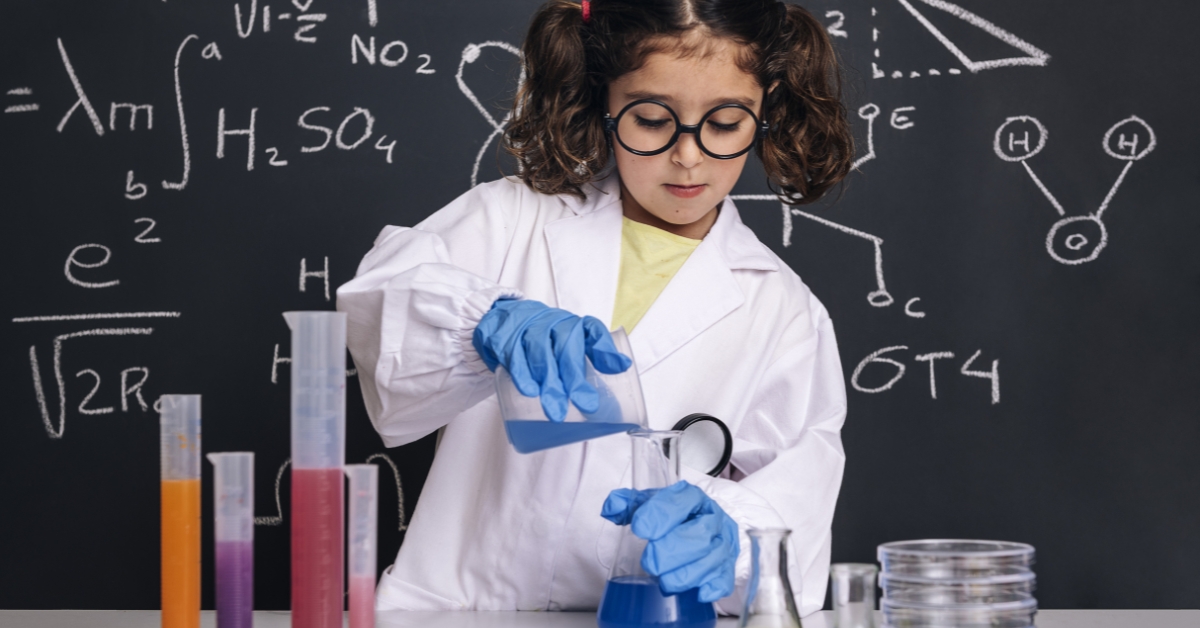Are you a homeschool parent eager to ignite your child’s love for science? Setting up a safe and effective DIY science lab at home can be a game-changer. A well-equipped home laboratory not only makes teaching science more engaging but also provides a hands-on learning experience that kids will cherish. In this blog post, we’ll explore everything you need to know about creating a homeschool laboratory that will turn your young scientists into passionate explorers. From safety tips to essential equipment, we’ve got you covered.
Creating a home science lab offers numerous educational benefits. It transforms abstract concepts into tangible experiences, making science for kids both fun and understandable. When children can see and touch what they are learning, their engagement and retention rates skyrocket. This hands-on approach to teaching science allows children to develop critical thinking skills and fosters a lifelong love of learning.
Another advantage is the flexibility it offers. Unlike traditional classrooms, a homeschool laboratory allows you to tailor experiments to your child’s interests and learning pace. This personalization can significantly enhance the learning experience, making complex subjects more accessible and enjoyable. Furthermore, having a science lab at home encourages self-directed learning, empowering kids to explore topics that intrigue them. Lastly, setting up a home lab can be a cost-effective way to provide high-quality science education. With a little initial investment, you can build a versatile lab that serves multiple educational purposes. Over time, the savings from not having to buy elaborate science kits or pay for expensive courses can be substantial.
Choosing The Right Space, Prioritizing Safety, & Essential Equipment
The first step in setting up a home science lab is choosing the right space. You’ll need an area that is well-ventilated, spacious, and easy to clean. Basements, garages, or even a well-ventilated corner of a living room can serve as excellent locations. Ensure that the chosen space has access to running water and electrical outlets, which are crucial for many experiments. Next, consider the layout of your lab. Organize your space into different zones for various activities. For example, you might have a wet zone for experiments involving liquids, a dry zone for paperwork and data recording, and a storage area for equipment and chemicals. This organization will help keep your lab neat and functional. Another important aspect is lighting. Good lighting is essential for conducting experiments safely and accurately. Natural light is ideal, but if that’s not possible, invest in some high-quality LED lights. Proper illumination helps in observing experiment details clearly, reducing the risk of errors and accidents.
Safety should be your top priority when setting up a homeschool laboratory. Start by educating your children about lab safety rules. These rules should include wearing safety goggles, gloves, and lab coats, as well as proper handling and disposal of chemicals. Make sure that all lab equipment is child-friendly and age-appropriate. Create a designated safety zone equipped with a first-aid kit, fire extinguisher, and emergency contact numbers. This area should be easily accessible and known to all members of the household. Regularly review and practice safety procedures to ensure that everyone knows what to do in case of an emergency. Labeling is another crucial safety measure. Clearly label all chemicals and equipment, indicating their potential hazards. Store hazardous materials in locked cabinets, away from the reach of children. By maintaining a well-organized and clearly labeled lab, you minimize the risk of accidents and ensure a safe learning environment.
Equipping your home science lab with the right tools is essential for effective teaching of science. Start with basic items like beakers, test tubes, pipettes, and measuring cylinders. These tools are fundamental for conducting a wide range of experiments and are readily available in most educational supply stores. Invest in a good quality microscope, as it opens up a world of microscopic wonders for your young scientists. A digital microscope that connects to a computer can be particularly useful, allowing for easy observation and recording of results. Additionally, consider buying a set of prepared slides to get started on microscopy experiments right away. A reliable heat source, such as a Bunsen burner or an electric hot plate, is also essential. These tools are used in various experiments requiring heat, from simple boiling to more complex reactions. Ensure that the heat source you choose is safe and suitable for use in a homeschool laboratory.
Using Chemicals & Ideas For Experiments
When it comes to chemicals and reagents, start with basic, non-toxic substances that are safe for children to handle. Baking soda, vinegar, food coloring, and salt are excellent starting points for simple yet educational experiments. These everyday items can demonstrate fundamental scientific principles without posing significant risks. As your child’s interest and expertise grow, you can gradually introduce more advanced chemicals. However, always prioritize safety. Purchase chemicals from reputable suppliers and ensure that they come with safety data sheets (SDS) that provide information on handling, storage, and disposal. Proper storage of chemicals is crucial. Store them in a cool, dry place, away from direct sunlight and out of children’s reach. Use airtight containers to prevent contamination, and label each container clearly. By maintaining strict storage practices, you can keep your homeschool laboratory safe and functional.
Now that your lab is set up, it’s time to get experimenting! Start with simple experiments that teach basic scientific principles. For instance, you can demonstrate chemical reactions by mixing baking soda and vinegar to produce carbon dioxide. This classic experiment never fails to amaze kids and provides a great introduction to chemistry. Another fun experiment is growing crystals. All you need is some salt, sugar, or baking soda and a bit of patience. This activity not only teaches kids about crystallization but also enhances their observational skills as they watch the crystals form over time. For biology enthusiasts, consider dissecting flowers or examining pond water under a microscope. These activities offer hands-on experience with biological concepts and help children appreciate the complexity of living organisms. Always supervise your children during these experiments to ensure safety and accuracy.
Keeping A Lab Journal & Incorporating Technology
Encourage your children to keep a lab journal. This practice helps them develop scientific thinking and record their observations, hypotheses, and conclusions. A well-maintained lab journal is an invaluable tool for tracking progress and reflecting on experiments, making it an essential part of teaching science. Instruct your children on how to structure their journal entries. Each entry should have a date, a title, an objective, a list of materials, a procedure, observations, and a conclusion. This format ensures that all crucial aspects of the experiment are documented, making it easier to replicate and understand later. Review the lab journal regularly and provide feedback. Praise detailed observations and thoughtful conclusions while suggesting improvements. This positive reinforcement encourages your children to take pride in their work and strive for accuracy and thoroughness in their scientific endeavors.
Technology can greatly enhance the learning experience in a homeschool laboratory. Utilize educational apps and online resources to supplement traditional experiments. Websites like Khan Academy and YouTube offer a wealth of tutorials and demonstrations that can clarify complex scientific concepts. Consider incorporating digital tools such as data logging software and virtual labs. These tools allow for more accurate data collection and analysis, providing a deeper understanding of scientific principles. Virtual labs, in particular, offer a safe and cost-effective way to conduct experiments that may be too dangerous or expensive to perform at home. Encourage your children to use digital cameras or smartphones to document their experiments. Photos and videos can be included in their lab journals, providing a visual record of their work. This practice not only enhances documentation but also makes science for kids more interactive and engaging.
Adapting To Different Learning Styles & Building Community
Building a sense of community can enrich your homeschool laboratory experience. Join online forums and social media groups dedicated to homeschooling and science education. These platforms offer a wealth of resources, including experiment ideas, troubleshooting tips, and support from fellow homeschool parents. Participate in local science fairs and competitions. These events provide opportunities for your children to showcase their work, receive feedback, and connect with other young scientists. They also offer a platform for your children to develop presentation and communication skills, which are crucial for their overall development. Consider organizing a homeschool science club with other families in your area. Regular meetings can provide a structured environment for conducting experiments, sharing findings, and learning from each other. This collaborative approach fosters a love for learning and builds a supportive community of like-minded individuals.
Every child learns differently, and a homeschool laboratory allows you to tailor your teaching methods to suit their unique needs. Some children may prefer hands-on experiments, while others might benefit from visual aids or written explanations. By understanding and adapting to these learning styles, you can make science for kids more effective and enjoyable. For kinesthetic learners, focus on hands-on activities and experiments that involve physical manipulation. These children learn best by doing, so provide plenty of opportunities for them to engage in practical work. Simple tasks like measuring ingredients or mixing solutions can be highly educational and enjoyable for these learners. Visual learners benefit from diagrams, charts, and videos. Use colorful illustrations and infographics to explain scientific concepts. Encourage these children to draw their observations and create visual representations of their findings. This approach helps them grasp complex ideas and retain information more effectively. Auditory learners thrive on verbal instructions and discussions. Explain experiments and concepts out loud, and encourage these children to talk through their observations and conclusions. Consider using educational podcasts or audiobooks to supplement their learning. This method helps auditory learners process information and engage with the material more deeply.
Building A Routine & Encouraging Curiosity
Establishing a regular routine for your homeschool laboratory can enhance consistency and productivity. Set aside specific days and times for conducting experiments and stick to this schedule as closely as possible. A predictable routine helps children develop good study habits and ensures that science remains a consistent part of their education. Start each session with a brief review of previous experiments and a discussion of the day’s objectives. This practice helps children connect new information with what they’ve already learned, reinforcing their understanding. Follow this with the main experiment or activity, ensuring that there is enough time for thorough exploration and documentation. End each session with a reflection period. Encourage your children to discuss what they’ve learned, any challenges they faced, and what they found most interesting. This reflection helps consolidate their learning and provides valuable insights for future sessions.
One of the most important aspects of teaching science is fostering curiosity. Encourage your children to ask questions, explore new ideas, and experiment with different approaches. A curious mind is a powerful tool for learning, and nurturing this quality can lead to lifelong intellectual growth. Create an environment where questions are welcomed and valued. Respond to your children’s inquiries with enthusiasm and provide them with the resources to find answers. This approach not only satisfies their curiosity but also teaches them how to seek knowledge independently. Incorporate open-ended experiments that allow for exploration and creativity. Rather than following a strict procedure, give your children the freedom to experiment with different variables and observe the outcomes. This method encourages critical thinking and problem-solving skills.
Transforming Your Child’s Education
Setting up a homeschool laboratory is a rewarding endeavor that can transform your child’s education. By providing a hands-on, engaging, and personalized approach to teaching science, you can ignite a passion for learning that lasts a lifetime. Remember to prioritize safety, invest in quality equipment, and adapt your teaching methods to suit your child’s unique needs. By fostering curiosity and building a supportive learning environment, you can create a homeschool laboratory that not only teaches science to kids but also inspires them to explore, discover, and grow. Happy experimenting!





